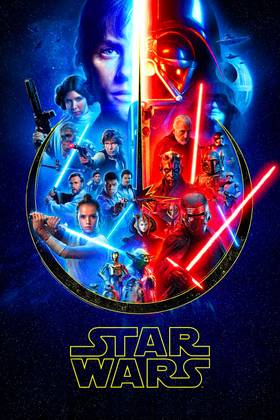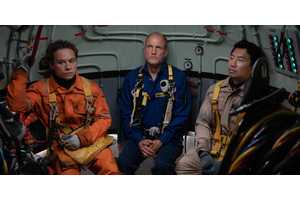Star Wars Needs to Revisit the Death Star's Partner, the Fortress Planet Bastion
The Death Star is the most infamous superweapon in Star Wars canon – but there is one powerful equivalent, from the franchise's old "Legends" continuity, the Fortress Planet Bastion, a fortified base of operations for the future version of the Galactic Empire, meant to withstand even the most devastating planetary attack.
Star Wars: Legacy #0 – written by John Ostrander, with art by Jan Duursema – introduced Bastion, the seat of the Fel Empire, a more benevolent Imperial dynasty that rules a significant portion of the galaxy.
As the issue emphasized, Bastion was designed to be one truly unassailable planet; essentially, it was the exact opposite of the Death Star, or as close as anything else in Star Wars canon: a planet-sized fortress, which could theoretically withstand the might of a planet-sized weapon.
The "Fortress Planet" Bastion's Role In The Star Wars' "Legends" Continuity, Explained
Star Wars: Legacy #0 – Written By John Ostrander; Art Bt Jan Duursema; Ink By Dan Parsons; Color By Brad Anderson; Lettering By Michael Heisler
Bastion, originally known as Sartinaynian, first appeared in the 2006 Dark Horse Comics series Star Wars: Legacy. This Outer Rim planet was renowned as far back as the Old Republic era as the terminus of a crucial hyperspace route in the galaxy's northern sector. In Legends continuity, Bastion gained prominence among Imperial officials and military leaders like Admiral Thrawn after the Galactic Empire's fall to the Rebel Alliance, becoming their new power base. Eventually, it served as the capital of both the Imperial Remnant and its successor, the Fel Empire.
Following the arrival of Imperial soldiers and officials on Bastion, the remnants of the once-mighty Imperial war machine began to consolidate and initiate military improvements on the planet. These enhancements not only symbolized the enduring relevance of Imperial power in the galaxy but also served as a defensive measure against enemies like the New Republic. Given the Imperial Remnant’s expertise in defensive fortifications, the task came naturally to them. Additionally, Bastion’s natural features —such as its moon and planetary rings— provided further protective advantages, bolstering its strategic significance.
Indeed, as it became increasingly clear, as time went on, that Bastion and the surrounding planets were the new home of the Imperial Remnant, successive leaders prioritized making their new homeworld as secure and defensible as possible. One key aspect of this effort involved transforming the once-sprawling Imperial military into a smaller, leaner, more disciplined, and deadlier force capable of achieving more with fewer resources. Another equally important aspect was making Bastion virtually impregnable – employing both planet-based and space-based fortifications and defense systems.
Bastion & The Death Star – The Two Sides Of Imperial Military Power At Its Finest
A Planetary Fortress Vs. A Planet-Sized Weapon
Everything the Death Star provided the Galactic Empire as a tool of military, political, and social power, Bastion matched—if not surpassed. The Death Star was an incomprehensibly complex technological marvel that performed its role flawlessly. Bastion, on the other hand, was a similarly intricate technological wonder, though it arguably demanded greater coordination and ingenuity to establish and maintain its viability. Both, however, shared a profound psychological impact: they instilled fear in the hearts of those who might dare to challenge the Empire’s authority.
While the Death Star sustained the Empire by crushing its opponents, Bastion sustained it by repelling its enemies, serving as a beacon of Imperial resilience.
The Death Star and Bastion share several symbolic elements that underscore their connection. The Death Star was a powerful symbol of Imperial dominance, making every soldier's job easier and boosting morale until its destruction. Similarly, after the Empire's defeat and humiliation at the hands of the Rebel Alliance, Bastion served as a protective stronghold, and also as a rallying symbol for Imperial loyalists across the galaxy. It provided a much-needed boost to their morale. In essence, while the Death Star sustained the Empire by crushing its opponents, Bastion sustained it by repelling its enemies, serving as a beacon of Imperial resilience.
Bastion Deserves The Spotlight – How It Could Be Brought Into The Contemporary "Star Wars" Canon
The Possibility Exists, Legacy Fans
While their goals differed and their operations were largely incompatible, the Death Star and Bastion ultimately represented the alpha and omega of Imperial military power. The story of Bastion offers a fresh and thought-provoking lens through which to analyze the Imperial Remnant’s retreat and restoration, following its repressive reign under Palpatine and its failure against the Rebel Alliance. It’s reasonable to argue that, at its peak, Bastion could withstand one of the Death Star’s planet-destroying beams. This resilience serves as a testament to the sacrifices made by the Empire in its effort to maintain a semblance of its former power.
Bringing Bastion into the fold would be a fantastic way for Star Wars to add yet another compelling layer to its ever-expanding narrative.
It wouldn’t be unprecedented to integrate Bastion into Star Wars canon. After all, it has a connection to another Legends story –namely that of Admiral Thrawn – which successfully made its way into the official Star Wars timeline. Furthermore, the Imperial Remnant is still canon. Bastion could easily serve as the hidden base for the Imperial Remnant forces seen in The Mandalorian and Ahsoka television series. It could also serve as the precursor to the First Order. Regardless of how it’s incorporated, bringing Bastion into the fold would be a fantastic way for Star Wars to add yet another compelling layer to its ever-expanding narrative.
Star Wars: Legacy #0 is available now from Dark Horse Comics.

- Created by
- George Lucas
- First Film
- Star Wars: Episode IV - A New Hope
Star Wars is a multimedia franchise that started in 1977 by creator George Lucas. After the release of Star Wars: Episode IV- A New Hope (originally just titled Star Wars), the franchise quickly exploded, spawning multiple sequels, prequels, TV shows, video games, comics, and much more. After Disney acquired the rights to the franchise, they quickly expanded the universe on Disney+, starting with The Mandalorian.










